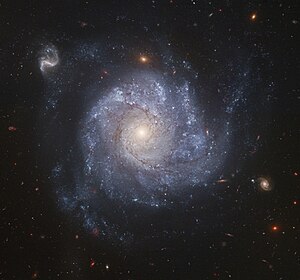NGC 1309
| Galaxy NGC 1309 |
|
|---|---|

|
|
| The galaxy NGC 1309 captured by the Hubble Space Telescope | |
| AladinLite | |
| Constellation | Eridanus |
|
Position equinox : J2000.0 , epoch : J2000.0 |
|
| Right ascension | 03 h 22 m 06.5 s |
| declination | -15 ° 24 ′ 00 ″ |
| Appearance | |
| Morphological type | SA (s) bc: / HII |
| Brightness (visual) | +11.5 mag |
| Brightness (B-band) | +12.3 mag |
| Angular expansion | 2.3 'x 2.2' |
| Position angle | 45 ° |
| Surface brightness | +13.1 mag / arcmin² |
| Physical data | |
| Affiliation | Eridanus Galaxy Cluster LGG 92 |
| Redshift | 0.007125 ± 0.000013 |
| Radial velocity | 2136 ± 4 km / s |
|
Stroke distance v rad / H 0 |
(93 ± 7) · 10 6 ly (28.4 ± 2.0) Mpc |
| history | |
| discovery | Wilhelm Herschel |
| Discovery date | October 3, 1785 |
| Catalog names | |
| NGC 1309 • PGC 12626 • MCG -03-09-028 • IRAS 03197-1534 • 2MASX J03220655-1524002 • GC 692 • H I 106 • h 2523 • HIPASS J0322-15b • LDCE 251 NED006 | |
NGC 1309 is a spiral galaxy of Hubble type Sbc in the constellation Eridanus south of the ecliptic . It is estimated to be 93 million light-years from the Milky Way and about 60,000 ly in diameter. It is one of over 200 galaxies that make up the Eridanus Galaxy Cluster.
In the same area of the sky are u. a. the galaxies IC 318 and IC 321 .
The Type Ia supernova SN 2002fk was observed here, the measurement of which contributed to the more precise determination of the distance.
The object was discovered on October 3, 1785 by the German-British astronomer Wilhelm Herschel .
Web links
Commons : NGC 1309 - collection of images, videos, and audio files
- Hubble Space Telescope
- Supernova SN 2002fk
- SIMBAD query
- NGC 1309 and Friends - Astronomy Picture of the Day, February 9, 2006.
